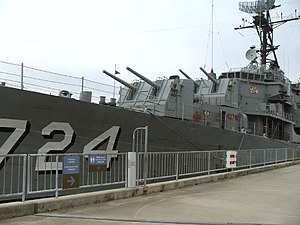This article needs additional citations for verification. (May 2018) |
 USS Laffey in 1959
| |
| History | |
|---|---|
| Name | Laffey |
| Namesake | Bartlett Laffey |
| Builder | Bath Iron Works |
| Laid down | 28 June 1943 |
| Launched | 21 November 1943 |
| Sponsored by | Ms. Beatrice F. Laffey |
| Commissioned | 8 February 1944 |
| Decommissioned | 30 June 1947 |
| Recommissioned | 26 January 1951 |
| Decommissioned | 9 March 1975 |
| Stricken | 9 March 1975[1] |
| Identification |
|
| Honors and awards | See Awards |
| Status | Museum ship at Patriots Point, South Carolina |
| Badge |  |
| General characteristics | |
| Class and type | Allen M. Sumner-class destroyer |
| Displacement | 2,200 long tons (2,235 t) |
| Length | 376 ft 6 in (114.76 m) |
| Beam | 40 ft (12 m) |
| Draft | 15 ft 8 in (4.78 m) |
| Installed power | 60,000 shp (45,000 kW) |
| Propulsion |
|
| Speed | 34 knots (63 km/h; 39 mph) |
| Range | 6,500 nmi (7,500 mi; 12,000 km) at 15 knots (28 km/h; 17 mph) |
| Complement | 336 |
| Sensors and processing systems | Radar |
| Armament |
|
 Laffey in 2007 | |
| Nearest city | Mount Pleasant |
| Coordinates | 32°47′23″N 79°54′28″W / 32.78972°N 79.90778°W |
| Built | 1943 |
| Architect | Bath Iron Works |
| NRHP reference No. | 83002189 |
| Significant dates | |
| Added to NRHP | 12 April 1983[2] |
| Designated NHL | 14 January 1986[3] |
USS Laffey (DD-724) is an Allen M. Sumner-class destroyer, which was constructed during World War II, laid down and launched in 1943, and commissioned in February 1944. The ship earned the nickname "The Ship That Would Not Die" for her exploits during the D-Day invasion and the Battle of Okinawa when she successfully withstood a determined assault by conventional bombers and the most unrelenting kamikaze air attack in history. Today, Laffey is a U.S. National Historic Landmark and is preserved as a museum ship at Patriots Point, outside Charleston, South Carolina.[4]
Laffey was the second ship of the United States Navy to be named for Bartlett Laffey. Seaman Laffey was awarded the Medal of Honor for his stand against Confederate forces on 5 March 1864.[5]
- ^ "USS Laffey DD 724".
- ^ "National Register Information System". National Register of Historic Places. National Park Service. 23 January 2007.
- ^ "Laffey, USS (Destroyer)". National Historic Landmark summary listing. National Park Service. Archived from the original on 5 October 2012. Retrieved 26 June 2008.
- ^ "Explore Museum". Patriots Point. Retrieved 4 September 2012.
- ^ "Destroyer Photo Index DD-724 USS LAFFEY". www.navsource.org. Retrieved 11 May 2018.
